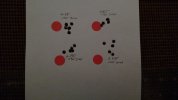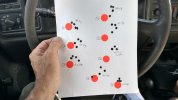MNbogboy
Well-Known Member
Theory on why...just like some of you say...dont know...
There is a correlation between seating depth & neck tension (grip). A major change in grip most often changes seating requiring new tests...then powder charge may also be affected....
At any rate a few things come to mind and all may or may not be factors....
1. Bullet speed at first engraving
2. Rate of deceleration before acceleration at the moment when the bullet first starts engraving.
3. Pressures at first moment of bullet contact with lands.
4. The above all have effect on barrel time.
5. Angle of the lead including erosion.
6. Bullet shape, material, bearing surface, fore/aft balance, reaction to the gas propulsion due to shape at the stern.
There are probably 100 more things that will affect best seating...we need the formula and tools to solve this mystery..lol
There is a correlation between seating depth & neck tension (grip). A major change in grip most often changes seating requiring new tests...then powder charge may also be affected....
At any rate a few things come to mind and all may or may not be factors....
1. Bullet speed at first engraving
2. Rate of deceleration before acceleration at the moment when the bullet first starts engraving.
3. Pressures at first moment of bullet contact with lands.
4. The above all have effect on barrel time.
5. Angle of the lead including erosion.
6. Bullet shape, material, bearing surface, fore/aft balance, reaction to the gas propulsion due to shape at the stern.
There are probably 100 more things that will affect best seating...we need the formula and tools to solve this mystery..lol


